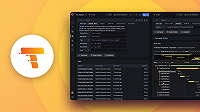Monitor Tempo
Tempo is instrumented to expose metrics, logs, and traces. Furthermore, the Tempo repository has a mixin that includes a set of dashboards, rules, and alerts. Together, these can be used to monitor Tempo in production.
Instrumentation
Metrics, logs, and traces from Tempo can be collected to observe its services and functions.
Metrics
Tempo is instrumented with Prometheus metrics and emits RED metrics for most services and backends. RED metrics are a standardized format for monitoring microservices, where R stands for requests, E stands for errors, and D stands for duration.
The Tempo mixin provides several dashboards using these metrics.
Logs
Tempo emits logs in the key=value (logfmt) format.
Traces
Tempo uses the Jaeger Golang SDK for tracing instrumentation. The complete read path and some parts of the write path of Tempo are instrumented for tracing.
You can configure the tracer using environment variables.
To enable tracing, set one of the following: JAEGER_AGENT_HOST and JAEGER_AGENT_PORT, or JAEGER_ENDPOINT.
The Jaeger client uses remote sampling by default, if the management server is not available no traces are sent. To always send traces (no sampling), set the following environment variables:
JAEGER_SAMPLER_TYPE=const
JAEGER_SAMPLER_PARAM=1Polling
Tempo maintains knowledge of the state of the backend by polling it on regular intervals. There are currently only two components that need this knowledge and, consequently, only two that poll the backend: compactors and queriers.
Refer to Use polling to monitor the backend status for Tempo.
Dashboards
The Tempo mixin has four Grafana dashboards in the yamls folder that you can download and import into your Grafana UI.
These dashboards work well when you run Tempo in a Kubernetes (k8s) environment and metrics scraped have the
cluster and namespace labels.
Tempo Reads dashboard
This is available as
tempo-reads.json.
The Reads dashboard gives information on Requests, Errors, and Duration (RED) on the query path of Tempo. Each query touches the Gateway, Tempo-Query, Query-Frontend, Queriers, Ingesters, the backend, and Cache, if present.
Use this dashboard to monitor the performance of each of the mentioned components and to decide the number of replicas in each deployment.
Tempo Writes dashboard
This is available as
tempo-writes.json.
The Writes dashboard gives information on RED on the write/ingest path of Tempo. A write query touches the Gateway, Distributors, Ingesters, and the backend. This dashboard also gives information on the number of operations performed by the Compactor to the backend.
Use this dashboard to monitor the performance of each of the mentioned components and to decide the number of replicas in each deployment.
Tempo Resources dashboard
This is available as
tempo-resources.json.
The Resources dashboard provides information on CPU, Container Memory, and Go Heap Inuse.
This dashboard is useful for resource provisioning for the different Tempo components.
Use this dashboard to see if any components are running close to their assigned limits.
Tempo Operational dashboard
This is available as
tempo-operational.json.
The Tempo Operational dashboard deserves special mention because it is probably a stack of dashboard anti-patterns.
It’s big and complex, doesn’t use jsonnet, and displays far too many metrics in one place.
For just getting started, the RED dashboards are great places to learn how to monitor Tempo in an opaque way.
This dashboard is included in the Tempo repository for two reasons:
- The dashboard provides a stack of metrics for other operators to consider monitoring while running Tempo.
- We want the dashboard in our internal infrastructure and we vendor the
tempo-mixinto do this.
Rules and alerts
The Rules and Alerts are available as YAML files in the compiled mixin on the repository.
To set up alerting, download the provided JSON files and configure them for use on your Prometheus monitoring server.
Check the runbook to understand the various steps that can be taken to fix firing alerts.


